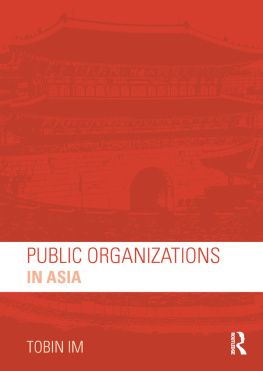Multicultural Organizations in Asia
A new study of how Asian Pacific organizations and private enterprises are expanding into markets beyond their national bases by transforming themselves in multinational and transnational directions.
It shows how multicultural relations are fundamental to such shifts. It explains the organizational processes that characterize economic restructuring and the transgression of state borders by organizations seeking economic opportunities. It shows how these ambitions require boundaries to be overcome both inside and outside of organizations.
This study also details the trend towards fluidity and complexity of boundaries both physical and symbolic within and outside of organizations due to the speeding up of key processes.
This, however, does not imply that boundaries are disappearing. Organizational change always challenges identities and sets new targets for this very identification. Mergers, acquisitions and strategic alliances all generate new organizational forms and necessitate the redefinition and renegotiation of organizational boundaries. The manifold ways in which organizational boundaries are affected by economic restructuring and at the same time affect social processes within and between organizations, in particular in the context of the booming economies of the Asia Pacific area is the focus of this volume.
This book was previously published as a special issue of the Asian Pacific Business Review.
Heidi Dahles is Professor in Organizational Anthropology in the Department of Culture, Organization and Management at Vrije Universiteit Amsterdam.
Loh Wei Leng is Professor in History at the University of Malaya, Kuala Lumpur. Her research interests focus on Business and Maritime History of Malaysia.
First published 2006 by Routledge
2 Park Square, Milton Park, Abingdon, Oxon, 0X14 4RN
Simultaneously published in the USA and Canada
by Routledge
711 Third Avenue, New York, NY 10017
Routledge is an imprint of the Taylor & Francis Group
2006 Taylor & Francis Ltd
Typeset in Times 11/12pt by the Alden Group Oxford
All rights reserved. No part of this book may be reprinted or reproduced or utilised in any form or by any electronic, mechanical, or other means, now known or hereafter invented, including photocopying and recording, or in any information storage or retrieval system, without permission in writing from the publishers.
British Library Cataloguing in Publication Data
A catalogue record for this book is available from the British Library
Library of Congress Cataloging in Publication Data
A catalog record for this book has been requested
ISBN 10: 0-415-36868-5 (cased)
ISBN 13: 978-0-415-36868-1 (cased)
CONTENTS
HEIDI DAHLES & LOH WEI LENG
KWOK-BUN CHAN, VIVIENNE LUK & GEORGE XUN WANG
HELEN KOPNINA
HEIDI DAHLES & MEREL BRUCKWILDER
GEESKE BOODE
SIERK YBEMA & HYUNGHAE BYUN
MHINDER BHOPAL & CHRIS ROWLEY
REBEKKA TIJSTERMAN
LOH WEI LENG & HEIDI DAHLES
HEIDI DAHLES & LOH WEI LENG
In Paulsen and Hemes seminal work titled Managing Boundaries in Organizations an edited volume published in 2003 the concept of organizational boundaries is comprehensively and critically assessed for the first time in organization literature. Triggered by the paradox that organizational boundaries are conceptualized in mainstream organizational theory as given, fixed and unambiguous while, at the same time, these boundaries are claimed to diminish and dissolve as a consequence of processes of globalization, Paulsen and Hemes conclude that:
Far from becoming boundaryless organizations may be conceptualized as operating within and between boundaries at many levels of organization. Rather than decreasing in number, boundaries proliferate. Rather than becoming simplified, they become more complex. What becomes crucial for analysis are the multiple ways in which boundaries are conceptualized and construed in particular contexts, and whether explanations that utilize boundary constructs are useful for describing social and organizational dynamics (2003: p. 303).
In organization studies, the concept of boundary serves as a useful metaphor for understanding organizational dynamics in a range of organizational contexts (2003: p. 303). As an analytical tool, boundaries can provide a profound understanding of the process of negotiating the limits between the organization and its environment. This process is one of inclusion and exclusion, of conflict and consensus. An organization may be defined as all action and interaction that takes place inside such negotiated and constantly debated boundaries. However, boundary making is not only a process that focuses on the outer limits between an organization and its environment. It is also an ongoing process within organizations where diverging interests may be structured around differences of status, class, gender, and ethnic and cultural background, establishing organizations as intrinsically diverse. As boundaries within and outside organizations are constantly created and recreated, drawn and redrawn, constructed and reconstructed, negotiated and renegotiated, crossed, contested, discussed, and transcended in organizational life, we agree with Paulsen and Hemes that the concept of boundaries is indispensable as an analytical tool in organizational studies. Answering their call to endeavour reinvestigating the making and remaking of boundaries, this introduction explores the ways in which the concept of boundaries can be taken further to contribute to organizational theory. This introduction is completed with an overview of how the concept of boundaries informs the contributions to this volume.
From Bounded Community to Borderless Network
In mainstream organization theory, boundaries have commonly been drawn analytically from an etic point of view (that is, by the analyst or researcher, based on objective criteria) to describe where an organization ends and where its environment starts. This approach is based on an image of organization-as-community bringing together people with a common aim and shared beliefs in narrowly circumscribed spaces with clear boundaries which informed a series of theoretical perspectives until the present day, including structural functionalism, contingency theory and market-based theories (Reed, 1999: pp. 3132). For a long time, organization studies were characterized by an orthodox approach underwriting notions of the unitary and orderly nature of organizations, consensus and coherence rather than conflict and dissent (Clegg & Hardy, 1999: p. 1). It was not until the mid-1970s that the writings of Max Weber on bureaucratization and of Foucault on disciplinary regimes took root in the analysis of organizations. Triggered by Weicks The Social Psychology of Organizing (1969), Silvermans Theory of Organizations (1971), Burrell & Morgans Sociological Paradigms and Organizational Analysis (1979) new paradigms of organizational analysis emerged depicting organizations in terms of arenas and battlegrounds instead of communities (such as in Lukes [1974] analysis of the multiple faces of power and Cleggs [1975, 1979] investigations into processes of power in organizations). This fragmentation perspective was fuelled by the understanding that organizations instead of being defined as well-circumscribed entities have come to be replaced by chains, clusters, networks and strategic alliances questioning the significance of an organizational focus. The clear boundaries that formerly circumscribed the organization became blurred. Clegg &Hardy (1999: p. 10) define these phenomena in terms of postmodern networked forms of organizations which distinguish themselves from the bureaucratic organization in that they become decentralized, internally differentiated, fluid and unstable. Therefore, these networked organizations may be appropriately defined in terms of configurations of people with partly converging and partly conflicting, but continually changing interests.








